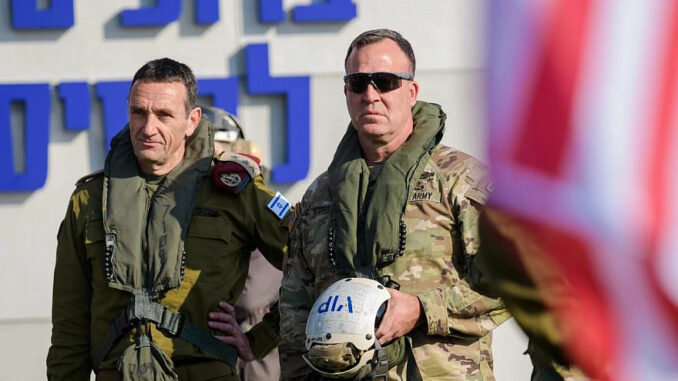Israel may still end up having to take on Iran’s nuclear program on its own, says former intelligence official.

(February 16, 2023 / JNS) On Jan. 26, the historic five-day joint Israeli-American military exercise called “Juniper Oak” came to an end. The exercise saw unprecedented levels of cooperation between the U.S. military’s Central Command (CENTCOM), which is responsible for the Middle East, and the Israel Defense Forces.
“Juniper Oak” tested Israeli-American readiness and boosted the operational connection between the two militaries to enable them to deal with “regional threats,” according to the IDF Spokesperson’s Unit, but the intended target audience for this message seems to have been Iran.
Some 6,500 U.S. commanders and soldiers took part, as did missile ships and fighter jets from both militaries, which fired on simulated naval threats. The two air forces also practiced a range of scenarios, including the use of transport and mid-air refueling aircraft, unmanned aerial vehicles, search and rescue helicopters and B-52 bombers, which dropped munitions on targets in southern Israel.
Out at sea, meanwhile, the Israeli Navy’s Sa’ar 5 missile ships were refueled by an American tanker, and in the air, fighter jets and bombers were refueled by Israeli and American refuelers, including the American Boeing KC-46 Pegasus, which will be in the IAF’s inventory in the coming years.
An initial review of the exercise was held by IDF Chief of Staff Lt. Gen. Herzi Halevi and CENTCOM Commander Gen. Michael E. Kurilla aboard an American aircraft carrier in the heart of the Mediterranean Sea. Members of the IDF General Staff and the U.S. Sixth Fleet also participated.
“The IDF and CENTCOM take the same view of regional threats,” said Halevi. “Israel knows how to defend itself, but it is always good when our best partner is with us so that we learn from one another.” Kurilla, for his part, said the U.S. is committed to Israel’s security and supports building up Israel’s qualitative military edge in the Middle East.
Still, despite the above, Israel has also been busy making its own, independent preparations for a potential strike on Iran—which have accelerated over the past year.
In 2022, the IAF placed long-range strike capabilities at the top of its priority list, with the IAF undertaking the most detailed planning regarding intelligence, munitions, aerial platforms and refueling capabilities.
“We have greatly sped up our preparations for activities in Iran,” then-IDF Chief of Staff Lt. Gen. Aviv Kochavi, stated in April 2022. “A substantial part of the enlarged defense budget, as just recently summarized, is earmarked for this. “
In June 2022, the IDF launched “Chariots of Fire,” a month-long military exercise and the largest in decades, which included simulations of long-range strikes against Iran’s nuclear sites.
Towards the end of the exercise, the IAF deployed dozens of aircraft over the Mediterranean in a drill to simulate “long-range flight, aerial refueling and striking distant targets,” according to the IDF.
A solo Israeli strike and a joint Israeli-American strike are both on the table, and both options must be taken seriously, a former intelligence official told JNS.
Brig. Gen. (res.) Yossi Kuperwasser, an ex-Military Intelligence Research Division head for the IDF and former director-general of the Israeli Ministry of Strategic Affairs, said the scenario of a joint operation “is certainly reasonable.”
“What has recently occurred is a convergence of U.S. and Israeli approaches,” said Kuperwasser, currently the director of the Project on Regional Middle East Developments at the Jerusalem Center for Public Affairs.
“While the United States understands the difficulties in renewing the nuclear agreement [with Iran], the Israelis abandoned the idea of enforcing a red line on Iran’s nuclear program, that was based on enriching 250 kilograms of 20 percent-enriched uranium, which Netanyahu had formerly marked out during a United Nations speech in 2012,” he said.
With the “trip wire” for action being moved by both countries, each in their way, they appeared to have settled on the idea of needing to act “one minute before Iran starts enriching uranium to the military-grade, 90 percent [U-235],” said Kuperwasser.
IDF Maj. Gen. (res.) Amos Gilead, executive director of the Institute for Policy and Strategy at Reichman University, Herzliya, and former director of policy and political-military affairs at the Israeli Defense Ministry, told 103FM on Thursday that U.S. support for Israel was critical for efforts to prevent Iran from going nuclear. Iran, he warned, is on the way to a nuclear weapon, and to stop it, “you need coordination with the U.S.”
On that same radio station, in July 2022, IDF Maj. Gen. Yaakov Amidror, former National Security Council head, stated, “We can strike Iran without the Americans, too. Perhaps not as well, but we must not as a country depend on the Americans.”
Kuperwasser pointed out that differences still remain in the way Jerusalem and Washington perceive the Iranian nuclear program. The U.S. could in theory live with Iran continuing to enrich uranium to the 60% level, while for Israel, this would represent an unacceptable situation, he said.
“Juniper Oak,” he said, “was designed to send a message to Iran: You are the target. The entire concept is about discouraging them from reaching 90% enrichment. The Iranians need to take it seriously. They could tell themselves that those who want to deter don’t do it as loudly. On the other hand, they cannot ignore this message.”



Leave a Reply
You must be logged in to post a comment.